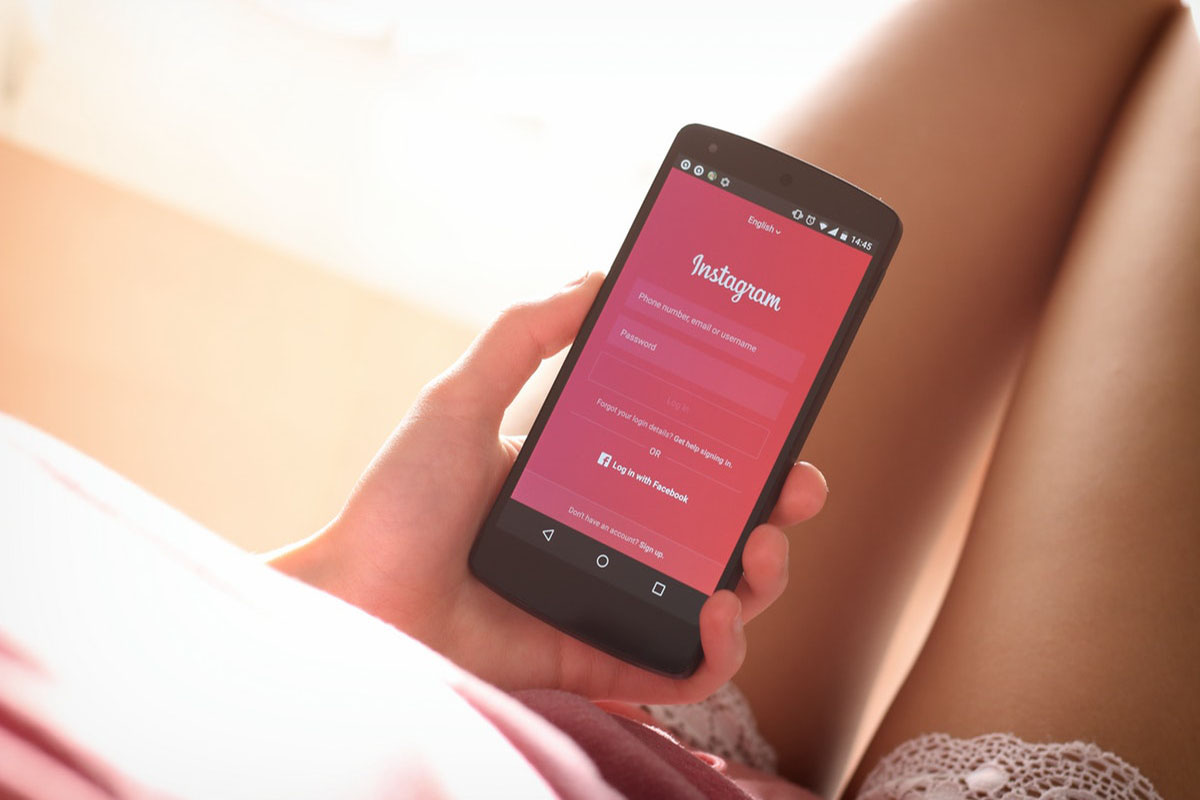A successful Facebook Ads campaign can make you a profit machine — a lucrative source of leads and sales.
As with all advertising platforms, you should consider the Facebook Advertising costs to see if you can make a good return on your investment. You might be wondering if Facebook ads are worth the effort if you have been advertising on other platforms.
We have created a guide on Facebook Ads costs to help you. We will cover the four billing options, the costs, and the factors that affect how much you pay for ads. Finally, we’ll show you the secrets of Facebook Ads.
Facebook Ads Costs: Average Price of Impressions, Clicks, Actions, and Engagement
You’ll choose a billing model that suits your goals, depending on the type of ad. The billing model determines how you pay for and bid for your ads.
These are the four main billing models:
- Cost per 1,000 impressions
- Cost per click
- Cost per action
- Cost per engagement
Let’s take a closer look at each and find out how much Facebook advertising costs. Remember that Facebook Ads costs may differ from these averages.
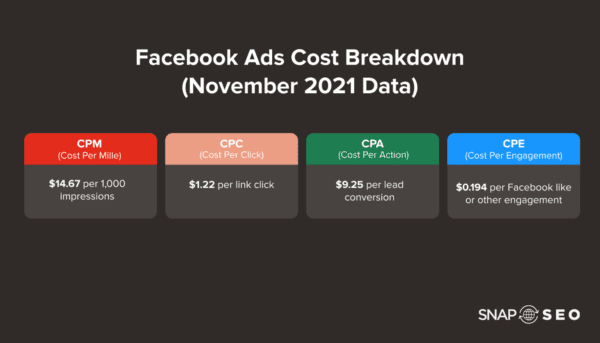
Cost per 1,000 impressions (CPM)
Impressions are a measure of how many times a Facebook user has seen your ad. Two impressions are when a user views your ad twice on Facebook. This tactic could be very useful if your goal is to increase brand awareness.
CPM stands for cost per 1,000 impressions — M stands for mille. Your CPM is your average cost for 1,000 individual ad view views.
If you spend $100 and get 10,000 impressions, your CPM would be $10.
November 2021 average CPM cost: $14.67 for all industries.
Cost per Click (CPC)
CPC refers to the cost per click you pay for every click on your ads. Optimize your ads for clicks if you want to increase your website visits.
Facebook calculates CPC by subtracting total ad spending from the number of clicks. CPC used to be calculated by counting clicks on all links within your ads. Facebook changed its policy in 2015 to only charge clicks on campaign-related links. However, you can still view “all clicks” in your performance reports.
Average CPC cost in November 2021: $1.22. It’s much lower than CPM because you typically need fewer than 1,000 impressions to drive a single click.
Cost per action (CPA)
CPA stands for cost per action, and it calculates the amount you spend on each conversion. The action can be defined as a new subscriber or a completed purchase.
The CPA you see in the report is the sum of your ad spending and the number of actions.
If you’re promoting an app, you should optimize your campaign to encourage app downloads if you are promoting an application. You should create a conversion action to send your newsletter to new leads.
Average CPA cost (for leads) in October 2021: $9.25. This price gets closer to CPM, as it might take hundreds of impressions of an ad to drive a single lead.
Cost per engagement (CPE)
To increase engagements and likes on Facebook posts, you can run CPE campaigns. You would optimize for engagements and calculate the CPE price. Facebook calculates CPE by dividing your ad spending by the number of likes and shares, reactions and other engagements.
November 2021 average CPE cost: $0.194. Because engagement is a simpler goal than clicking and leads, it’s inexpensive. Because it happens within the platform, there is less resistance from users.
You can’t simply create a campaign and expect the
How are Facebook Ads Costs Calculated?
Facebook Ads uses AI-powered, real-time auctions in order to determine the cost of each impression and click. Many factors can impact this price. The cost of your Facebook ad campaigns will be affected by location, interest, audience age, year and placements.
We have listed the key factors that affect how much you will pay for each:
average price per lead or conversion.
You may pay per lead, click or action. However, Facebook calculates the price using the impressions required to generate the results.
If Facebook estimates you’ll use $15+ worth of impressions to get a lead, a bid of $5 CPA won’t get you any traffic. Your bid must be able to compete for every potential ad view.
Every model uses CPM once you break it down. Your CPC and CPA will be lower the fewer impressions required to generate a click, lead or sale.
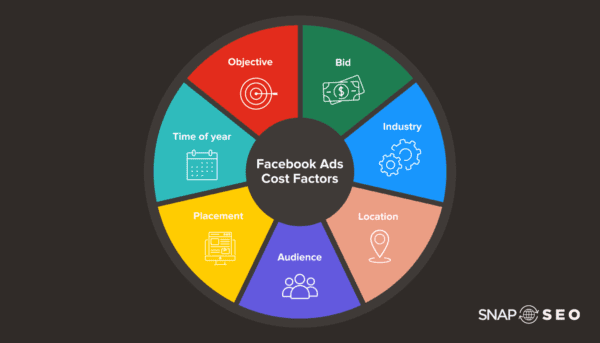
Demographics and audience
Costs can vary depending on the demographic and psychographic profile of your audience.
Campaigns targeting Americans 65+ may cost more than campaigns targeting those between 25 and 34 in the U.S.
This is because only 10.6% of Facebook users are over 65, and they are often a lucrative target.
Psychographics may also play a role. A good example is a customer who is interested in products from a specific industry. This can lead to higher impression costs.
Location
Facebook offers geotargeting, which allows you to target customers based on their location. You can target a specific area if you are a local business.
This is ideal for brick-and-mortar businesses as it gives you the power of enterprise geofencing without the high price.
Some areas may be more expensive than others. For example, targeting customers in New York City is more expensive than targeting customers in a small town because of the high competition.
Objective
Facebook has three main objectives that you can use to guide your campaigns:
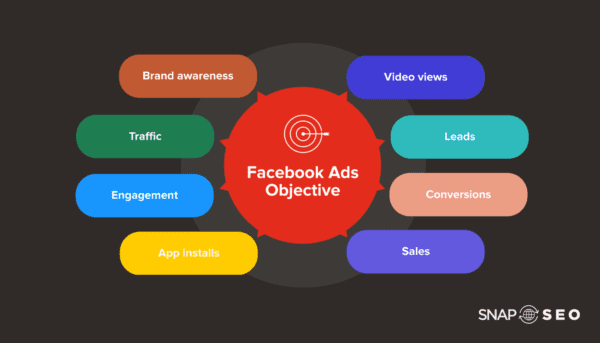
- Awareness
- Consideration
- Conversion
Each one has various sub-objectives within. For instance, the consideration objective has sub-objectives like traffic and video views.
Objectives closer to the sale — such ad add-to-carts or actual purchases — will cost more. Because Facebook’s algorithm believes these users are close to making a purchase, every impression costs more.
Time of the year
Businesses spend more advertising during peak seasons, such as the holiday season. You will have to pay more to get your ads seen by customers if there is more competition for the same ad space.
CPMs rose 30% in Thanksgiving Week, November 2020, as businesses prepare for Black Friday and other holiday shopping.
Industry
Some industries are more susceptible to customer objections than others and face stiffer competition. Driving a single click or lead in high-ticket industries will be more expensive.
Internet and telecom companies were the most expensive CPC payers in 2020 at $3.07. The lowest CPC was paid by the food and beverage industry at $0.42 percent in 2020.
Placement
Facebook ads can be placed in six different places on multiple social media platforms:
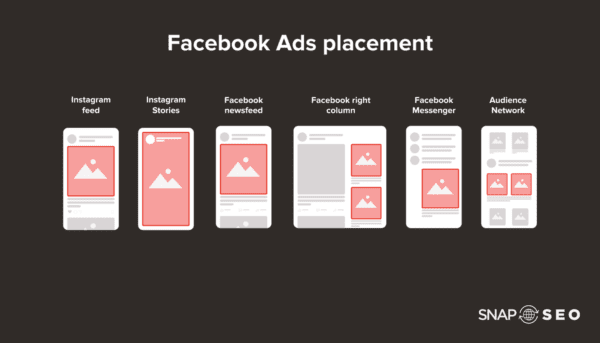
- Instagram Stories
- Facebook newsfeed
- Facebook right column
- Facebook Messenger
- Audience Network
CPMs will rise if the placement is more competitive. Although individual placements may vary, ads on Facebook are generally less expensive than Instagram ads.
What is the process of Facebook Ad Bidding?
Facebook sells its ads to businesses competing for these spots. Your bid and other factors will determine where you place. The highest bidder usually wins the ad placement, but this may change from time to time.
The highest bidder ad might not be relevant to their target audience. This will not result in clicks or sales and could damage Facebook’s reputation over the long term.
Facebook considers much more than the bid amount when determining the winner of a particular placement.
We’ll be covering the Facebook algorithm and then going over the bidding strategies you can try.
Facebook’s algorithm: Factors that go beyond price
Facebook’s algorithm relies on two factors to auction off ad view views. Facebook, the advertiser and the user win.
Your bid”
The maximum amount you will pay for a bid is your bid.
You won’t always be paying your maximum bid amount. Facebook’s advertising system ensures you only pay what you need to beat other bidders.
Let’s take, for example, a competitor bidding $1.50 and you bidding $1.75 to place an ad. Facebook will not charge $1.75; they will charge $1.51 per ad placement.
If you’re bidding for clicks, Facebook also has to factor in how likely your ad will get clicks. After all, even if you’re bidding $0.50, if your ads get four times more clicks than an ad bidding $1.80, your ad should win.
This is where relevance in advertising comes in.
Ad relevance:
Facebook evaluates how relevant an advertisement is to a specific audience. This means that Facebook considers how likely your ad will generate clicks or other actions.
Facebook used a simple relevance score system for assessing ad relevance. Facebook now uses ad relevance diagnostics to help make ad relevance clearer and easier to act on.
There are three types of relevance diagnostics:
Quality Ranking:
How other ads for the same audience perceive your ad. Facebook evaluates ad quality by user actions (likes, comments, clicking, etc.). and by analyzing low-quality attributes such as sensationalized speech.
Engagement rate Ranking: Compare your ad to others for the same audience. This excludes engagement-baiting tactics like asking for comments and likes.
Conversion rate ranking:
Compare your ad to others with the same optimization goal and target the same audience. It assesses both your landing page and your conversion flow, not your ad.
Facebook allows you to group your ad in one of five categories, each for each diagnostic.
Below Average (Bottom 10%)
Below Average (Bottom 20 percent of ads)
Below Average (Bottom 35% ads)
Average
Above Average
This may seem like a lot. Snap SEO can help you if you are unsure where to begin. Be Sure to reach out.
Bidding on a spend basis
Spend-based bidding strategies allow you to spend all of your budget and get the best results.
Facebook offers two spend-based automated bidding strategies
- Lowest cost strategy: Aims to get the most conversion opportunities for your budget — but there’s no maximum cap per action, click, or view. A lowest-cost strategy opens you up to more bid opportunities, but you may pay more since you don’t control your bids. It works well if you don’t have specific CPA requirements.
- The highest-value strategy: Aims to spend your entire budget but get the highest value purchases instead of the highest number of purchases. In other words, this will try to target big spenders rather than as many customers as possible.
Goal-based bidding
You can maximize certain actions and results using goal-based bidding with specific cost goals.
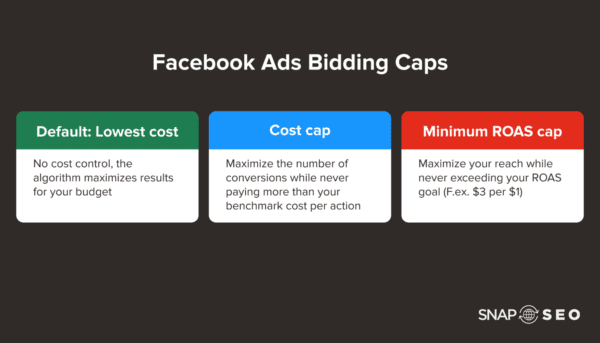
- Cost cap strategy: This tactic is based on cost control. This is where you set a target cost per activity that you want Facebook to try to keep close to. You may set a target price per purchase to maintain a certain profit margin. The target cost per purchase will not exceed that amount, but you should end up paying less.
- Minimum return on ad-spend strategy: This allows you to set a goal for the minimum return (ROAS) you would like for each bid. Decimals are used to set targets. If you want to make at least $120 per $100 spent on advertising, you will set a 1.200 ROAS limit. This strategy is similar to the highest-value strategy. Still, you won’t spend all of your ad budget if this is not possible.
Manual bidding
Facebook allows you to control the amount you bid in your auctions via manual bidding. Instead of Facebook changing bids case-by-case, you can set the maximum bid across all auctions.
Smaller companies can use this algorithm. The algorithm may be unable to efficiently spend your investment if it doesn’t have a lot of data. It is possible to set your maximum bid at a profit and still advertise without losing any money.
Here are some best practices to lower the cost of Facebook ads
Now that you know how Facebook Ads work and how much they cost, let us look at best practices to reduce campaign costs and improve ROI.
Hone in your targeting
You must first nail your targeting. Begin with customer research. Getting to know your target audience more than they do is important. This will allow you to adjust your targeting within the Facebook Ads platform.
Your ads will be more relevant to your audience if you can define them well, ultimately lowering your costs.
Facebook’s algorithm can also be used to assist you.
Use lookalike audiences
Lookalike audiences are groups of users similar to people who took a certain action related to your business. For example, it could be people similar to those who liked your page or bought a product.
You can use the Facebook Pixel or plug in a specific audience to be your “source audience.” Facebook then uses the data from that audience to identify potential new audiences.
Try something new!
Advertising is about tweaking and testing. Try out different ad images and copy to reduce ad costs.
Advertisement groups should include at least three variations of your ad idea.
Once you have a working version, keep testing the newer versions. This will allow you to reduce ad costs and decrease ad fatigue.
Match the creative with the ad placement
Facebook offers many options for where you can place your ad, with different dimensions and user interfaces. This is something you should consider when creating an ad.
An Instagram story ad, for example, should look different from a Facebook newsfeed advertisement.
Retargeting is a great option
In many industries, it is almost impossible to convert cold traffic — people who have never seen your product.
Retargeting — or remarketing — on Facebook circumvents that by putting ads in front of people who already interacted with your brand. You can run special sales promotions to existing subscribers, people who like your page, or previous customers.
Test different bidding strategies
Testing is the key to success when advertising on Facebook. If one bidding strategy isn’t working — even after changing the creative and audience — switching bidding strategies could help.
Use a strong call to action (CTA)
CTAs are a common Facebook Ads error. While it’s fine to be creative, your ad must match the content of your landing page, and you risk low relevance scores and lower conversion rates if it doesn’t.
Include a CTA such as “Get free shipping if your order is before December 17” to drive home the point and increase your ad’s performance.
Don’t be afraid to break the rules
You should not dismiss an idea you have for an advertisement without testing it. The best performers often come from completely unexpected angles or designs.
Conclusion
The key to success with Facebook Ads campaigns lies in controlling your costs. Understanding how the algorithm works is the first step to turning your Facebook page into a thriving ad revenue source. This will allow you to weigh your options for bidding strategies.
Testing is the key to running successful ad campaigns on any platform. It’s impossible to predict how well a product will perform until you have it in front of potential customers.
You can find winning campaigns by spending time exploring your options and trying out new strategies.
Schedule a call today to get expert advice and take the easy route to create impactful campaigns immediately.




